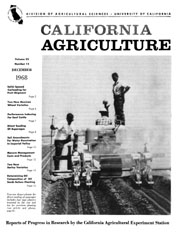


University of California
California Agriculture
|
|||
|
|||

Two-row shaper-planter for direct seeding of asparagus includes four tape planters mounted on the rear tool bar for precision planting.
December 1968
Volume 22, Number 12 |
|||
|
University of California, 1301 S. 46th St., Bldg. 478 Richmond, CA
|